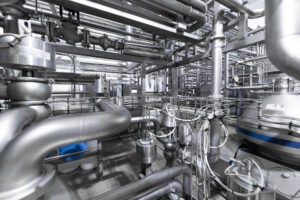 Working in the pharmaceutical manufacturing industry may bring many rewards, but it also has an element of risk. We often work alongside hazardous chemicals, in both labs and manufacturing spaces. Some in the industry operate with (or in proximity to) heavy equipment and industrial machinery.
Working in the pharmaceutical manufacturing industry may bring many rewards, but it also has an element of risk. We often work alongside hazardous chemicals, in both labs and manufacturing spaces. Some in the industry operate with (or in proximity to) heavy equipment and industrial machinery.
For those in harm’s way, the Environment, Health & Safety (EHS) group is arguably one of the most important teams in a pharma plant. The EHS team coordinates all safety program components, including occupational safety, plant safety, process safety and more.
It is important to distinguish between occupational and process safety hazards. Personal or occupational hazards resulting in injuries like slips, trips, falls and cuts impact one individual in a workplace. Process safety hazards, however, may result in major accidents such as fires and explosions or involve the release of dangerous materials. These potentially severe incidents can have catastrophic effects resulting in multiple injuries and fatalities. Process safety hazards pose a threat not only to workers inside a plant, but also to the nearby public.
Among the various areas of EHS responsibility, the process safety group is responsible for minimizing the risks that come with handling chemicals. Their key task? Running tests to identify potentially hazardous reactions and developing the steps necessary to control the release of hazardous material and energy from process operations.
Managing the Increased Risk of Hazardous Reactions During Scale-Up
In any situation where chemicals are being used, there is a risk. In pharmaceutical manufacturing, that risk increases exponentially during scale-up from the lab bench to commercial scales. When higher quantities of chemicals are used, the chance for a reaction is much greater. Challenges which arise during scaling typically involve heat-loss behavior, which can elevate pressure or create heat-related safety issues. The principal factor in determining severity is the energy present in the chemical process, which is directly related to the quantities of chemicals in use. The effects of scale-up – namely, from laboratory or pilot to full commercial scale – has a significant impact on the balance between heat generation and heat loss.
 Performing a proper process safety assessment is required for any chemical process to be executed at volume. At scale, hazardous reactions can have severe consequences – whether it is an operator injury, facility or equipment damage, or the loss of time to meet deadlines. In some cases, process safety failures may lead to financial loss and a tarnished corporate reputation.
Performing a proper process safety assessment is required for any chemical process to be executed at volume. At scale, hazardous reactions can have severe consequences – whether it is an operator injury, facility or equipment damage, or the loss of time to meet deadlines. In some cases, process safety failures may lead to financial loss and a tarnished corporate reputation.
In the worst-case scenario, there can be significant loss of life, such as the 1984 release of methyl isocyanate in Bhopal where thousands of people died, or the effects on plants and humans from long-term exposure to dioxins at Love Canal in New York. Process safety focuses on ensuring that no organization or community need endure such an incident.
How Important is Process Safety?
According to the authors of the Organic Process Research & Development article (Process Safety in the Pharmaceutical Industry—Part I: Thermal and Reaction Hazard Evaluation Processes and Techniques):
“The most seasoned practitioners of process chemistry and engineering would agree that safety is of paramount importance in running on scale and cannot take a back seat to any other process characteristics.”
We agree, and that’s why we have created a culture of “safety first, quality always.” This philosophy is part of ‘The Neuland Way.’ We are a quality-conscious and value-based company committed to making a difference in people’s lives – which means safety always comes first for our team and our customers.

Begin with a Trained and Experienced Team Running Safety Tests
All chemical accidents are preventable, provided enough is known about the process details and the science. For this reason, the process safety team is always comprised of a highly trained staff with deep knowledge of chemistry. Neuland’s process safety personnel are scientists who understand the details of the process in question and have a holistic awareness of manufacturing at scale.
To safely execute a chemical process, the process safety lab (PSL) performs a series of tests which offer a predictive analysis of the following:
- Pressure build-up and energy liberated
- Exotherms
- Onset temperatures and criticality classes 1 through 5
- Static charge
- Flammability
- Physical and chemical properties of the material being used and produced
- Anything else related to OHC 1-5
The results of these tests lead the team to make suggestions for the next steps. That could mean moving forward as planned, or it could mean making adjustments to meet safety protocols. The PSL remains constantly alert to any process changes, examining processes and running tests as needed.
Tests, of course, are a big part of what the process safety team does. But this begs the question – how much safety analysis is enough?
We rely on the team’s expertise to help make the right decision of what constitutes sufficient analysis. Based on their experience, they may perform a basic ‘fit-for-purpose’ assessment while prioritizing safety in the beginning stages. However, as the molecule advances into larger batches to meet developmental supplies for Phases 1 through 3, process safety development must shift to developing an efficient, efficacious and reproducible process. As process safety experts, they do whatever it takes to thoroughly understand the potential hazards in both the lab and the plant.
Safety as a Part of Team Culture
The goal of any process safety team is to do the right thing to protect the organization and the wider community. At Neuland, we recognize that safety isn’t just a series of steps we take to avoid disaster. It’s part of our culture, and it preserves the integrity of what we do.










